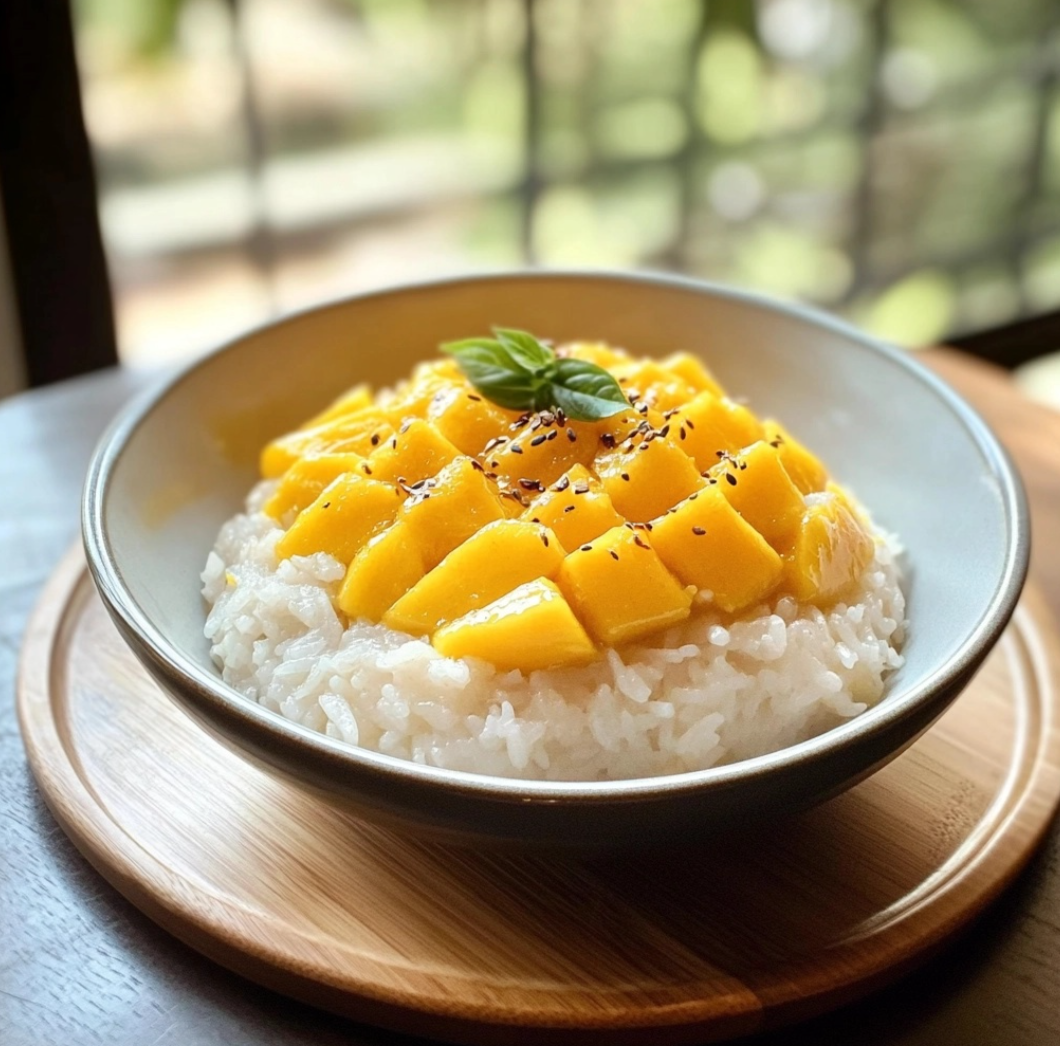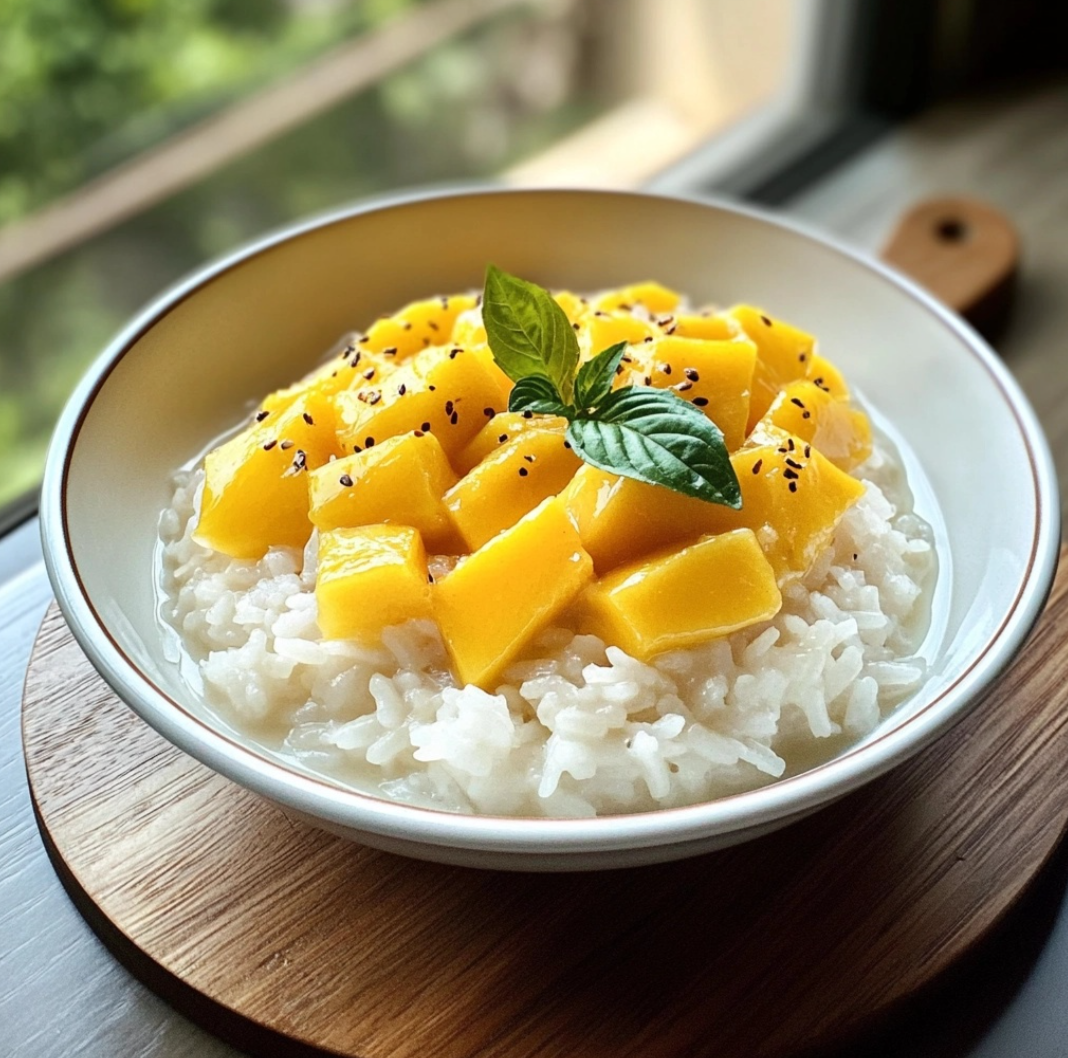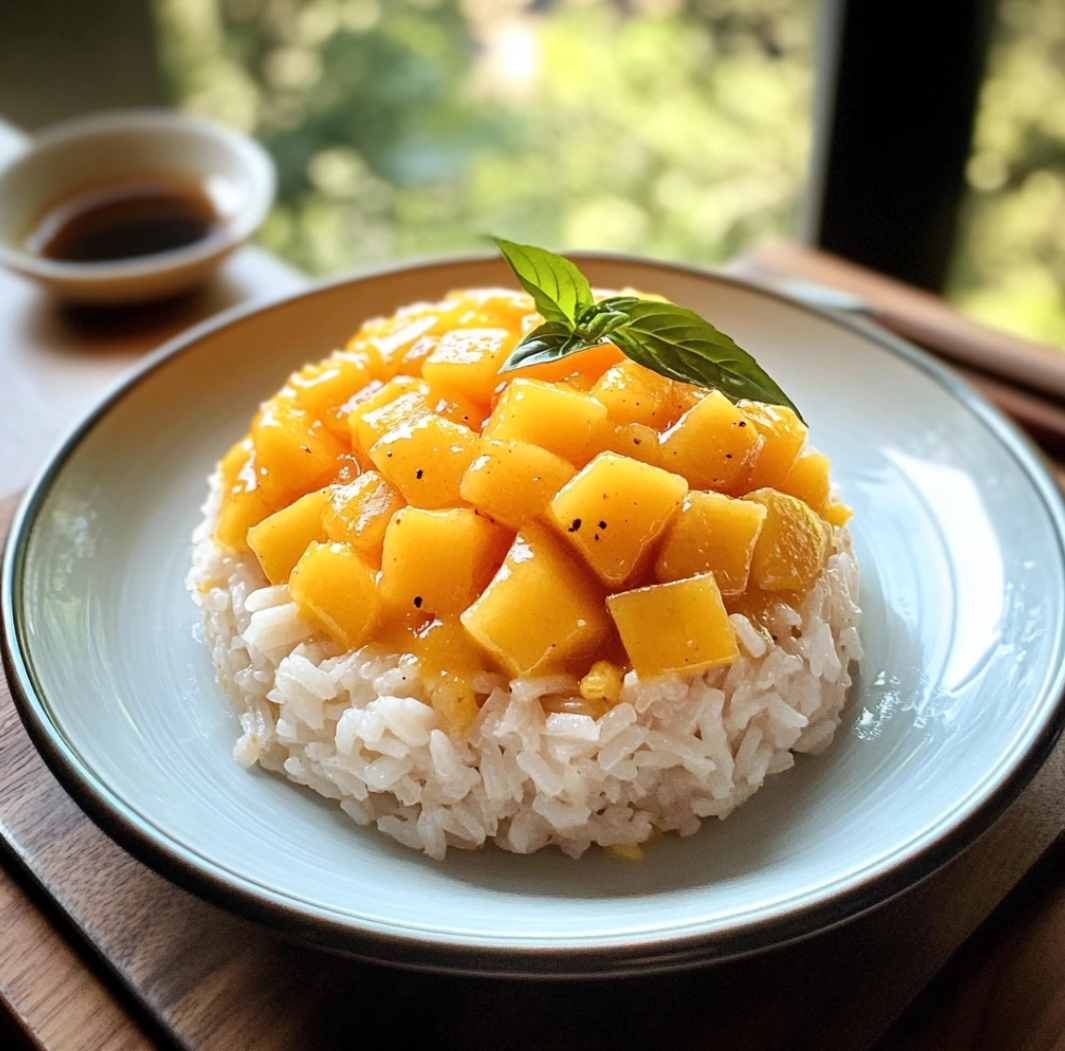1. Introduction to Mango Sticky Rice
What is Mango Sticky Rice?
Mango Sticky Rice, or “Khao Niew Mamuang” in Thai, is a traditional dessert originating from Thailand, often enjoyed during mango season. Known for its unique combination of flavors and textures, this dish is made from glutinous (sticky) rice, coconut milk, and ripe mangoes. It’s loved for its simplicity and is often served in Thai restaurants worldwide.
Why Try Mango Sticky Rice?
This dessert offers a delightful balance between creamy, sweet, and slightly salty flavors, which makes it refreshingly unique. The smoothness of the mango complements the sticky rice, creating an indulgent, comforting treat.

2. Basic Recipe
Ingredients
- Glutinous Rice: 1 cup (also known as sticky rice)
- Coconut Milk: 1 1/2 cups
- Sugar: 1/2 cup
- Salt: 1/4 tsp
- Ripe Mangoes: 2 (peeled and sliced)
- Sesame Seeds or Mung Beans: Optional garnish
Instructions
Step 1: Prepare the Rice
- Rinse the glutinous rice under cold water until the water runs clear.
- Soak the rice in water for at least 4 hours, or overnight for optimal texture.
Step 2: Steam the Rice
- Drain the soaked rice and place it in a steamer lined with cheesecloth or a clean kitchen towel.
- Steam for 30-40 minutes until the rice is tender and fluffy.
Step 3: Make the Coconut Sauce
- In a medium saucepan over medium heat, combine the coconut milk, sugar, and salt.
- Stir gently until the sugar dissolves. Avoid bringing it to a boil.
Step 4: Combine Rice and Coconut Sauce
- Transfer the cooked rice to a mixing bowl.
- Pour about 1 cup of the sweetened coconut milk over the rice, mixing thoroughly.
- Let the rice sit for 30 minutes to absorb the coconut flavor.
Step 5: Serve
- Serve a generous scoop of sticky rice on a plate, topped with sliced mango.
- Drizzle the remaining coconut milk over the dish.
- Garnish with sesame seeds or mung beans if desired.
3. Advanced Techniques and Tips
Enhancing the Coconut Sauce
For a richer sauce, consider simmering the coconut milk with pandan leaves, a popular addition in Southeast Asian cuisine. The leaves will infuse the coconut milk with a subtle, aromatic flavor that complements the mango and rice.
Adjusting Sweetness and Texture
- Sweeter Sauce: Adjust the sugar in the coconut sauce according to taste. A little extra sugar can help balance particularly tart mangoes.
- Smoother Texture: Strain the coconut milk before heating to remove any graininess for a silkier sauce.
Adding a Crunchy Topping
To add contrast in texture, try frying mung beans until golden and sprinkling them over the sticky rice. This is a traditional garnish in Thailand and adds a slight nuttiness to each bite.

4. Maintenance and Storage Tips
Storing Leftovers
If you have leftovers, store the sticky rice and coconut sauce separately in airtight containers.
- Rice: Refrigerate and consume within 2-3 days. Reheat gently by steaming or microwaving with a damp paper towel to retain moisture.
- Coconut Sauce: Store in the refrigerator for up to 3 days. Reheat over low heat, stirring to prevent separation.
Freezing Mango Sticky Rice
While fresh mangoes are best, the sticky rice portion can be frozen if needed. Wrap the rice in plastic wrap, place in an airtight container, and freeze for up to a month. Thaw and steam to reheat.
5. Dietary Adaptations
Vegan and Dairy-Free
The traditional Mango Sticky Rice recipe is already vegan and dairy-free, as it relies on coconut milk instead of dairy products. Be sure to use coconut milk without any added dairy.
Low-Sugar Option
For a less sweet version, reduce the sugar in the coconut sauce by half or replace it with a natural sweetener like maple syrup or agave. This adaptation maintains the flavors while lowering the glycemic index.
Gluten-Free
This dish is naturally gluten-free since glutinous rice (sticky rice) does not contain gluten, making it suitable for those with gluten sensitivities.

6. Frequently Asked Questions
Can I Use Regular Rice Instead of Sticky Rice?
No, regular rice will not achieve the same texture as glutinous rice, which has a unique stickiness essential for this dessert. However, sushi rice can be used as a substitute if glutinous rice is unavailable.
Why is My Rice Not Sticky Enough?
Sticky rice requires soaking for at least 4 hours before cooking. If your rice isn’t sticky, it may not have been soaked long enough. Additionally, glutinous rice must be steamed, not boiled, to achieve the correct texture.
What Mango Varieties Work Best?
Thai mangoes, such as Nam Dok Mai, are ideal due to their sweetness and low fiber content. However, Ataulfo or Honey mangoes are also great options if Thai varieties are not available.
Can I Make Mango Sticky Rice Ahead of Time?
Yes, but keep the components separate until serving. Store the sticky rice and coconut sauce in the refrigerator, then reheat and combine them just before serving to maintain the best texture and flavor.
What Can I Use as an Alternative to Coconut Milk?
For a different twist, try using almond milk or oat milk, though the flavor will differ from the traditional coconut milk. You may also add a bit of coconut extract to achieve a closer taste.
Conclusion
Mango Sticky Rice is a quintessential Thai dessert that embodies the harmony of flavors and textures in Southeast Asian cuisine. With each bite, you experience the creamy richness of coconut milk, the subtle sweetness of glutinous rice, and the refreshing taste of ripe mango, creating a perfect balance that leaves a lasting impression. This dessert is simple enough for beginners yet offers room for customization and creativity, making it an exciting addition to any home cook’s repertoire.
Beyond its delightful taste, Mango Sticky Rice also carries cultural significance, often served during celebrations and festivals in Thailand. By making it at home, you’re not just enjoying a dessert; you’re connecting with a beloved culinary tradition. The techniques and adaptations provided in this guide allow you to personalize the dish, whether you’re looking for a vegan option, a low-sugar version, or an extra touch of texture with toasted toppings.
So, don’t hesitate to try this recipe and bring a taste of Thailand into your kitchen. Whether you’re serving it to family, friends, or simply indulging on your own, Mango Sticky Rice promises to be a memorable treat that delights the senses and transports you to tropical shores with every bite.

